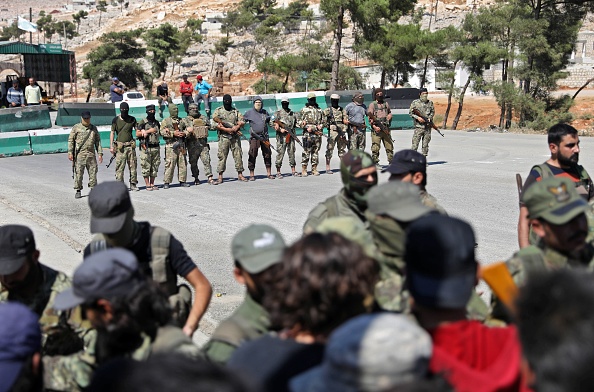A U.S.-led military coalition succeeded in toppling the self-declared caliphate of ISIS, in Iraq and Syria just this past March. Remarkably, only around 2,000 U.S. troops took part in this effort, a tiny fraction of those deployed to Iraq or Afghanistan at the heights of those wars. The key to success in Syria was that the United States worked “by, with, and through” local militia forces, namely the Syrian Democratic Forces (SDF), whose backbone was the Kurdish militia known as the People’s Protection Units (YPG).
And yet, with a single call to Turkish President Recep Tayyip Erdogan, U.S. President Donald Trump reportedly greenlit a Turkish assault on those same Kurdish partners, whose close ties to Kurdish militants in Turkey had long unnerved Ankara.Trump ordered the withdrawal of U.S. troops that had been training and assisting the SDF as part of an effort to preserve the coalition’s gains against ISIS. Turkey then launched a bloody campaign to push the Kurds away from the Turkish-Syrian border. With the SDF distracted, ISIS, ever adaptive and resilient, appears poised to exploit the chaos. Reports that ISIS militants have already escaped from Kurdish-run prisons have sparked fears that extremism could rise from the ashes in Syria.
The reality is that ISIS and al Qaeda were enjoying a resurgence even before Trump’s withdrawal and the Turkish invasion—ISIS in eastern Syria and al Qaeda in the west of the country. Now, with the United States headed for the exits, the Kurds battling Turkey, and the Assad regime and its backers focusing on other priorities, no force is left to counter an extremist revival. Further conflict will only fuel radicalization, which will once again destabilize the region and pose threats to Israel, Europe, and even the United States. Tragically, a few years from now, Syria will be right back where it was before the campaign against ISIS: suffering from chaos and conflict, with terrorism ascendant.
THE GATHERING STORM
The last piece of the ISIS caliphate, in Baghouz, Syria, fell to coalition forces in March. ISIS leaders were even then busy reconstituting their group as a rural insurgency. Tens of thousands of fighters had died defending ISIS strongholds in the Euphrates River valley—but thousands of others had retreated to safe havens in the Syrian and Iraqi countryside and survived. Among these was the group’s leader, Abu Bakr al-Baghdadi.
ISIS has spent recent months regrouping in rural sanctuaries, carrying out guerilla assaults on SDF patrols, and gathering its forces for later attacks on important cities and towns. In Raqqa and Dayr az Zawr, clandestine ISIS cells are collecting intelligence that will help the group plan assassinations, suicide attacks, and abductions. Such operations are meant to eliminate capable SDF commanders and to pressure Arab tribal leaders to work with ISIS instead of the SDF. In short, ISIS is grooming the battlefield militarily, politically, and psychologically so that it can go on the offensive as soon as the U.S.-led coalition withdraws.
Al Qaeda is likewise adapting and gathering strength in western Syria. The group has thrived in the chaos of Idlib Province, the last remaining opposition stronghold, which came under assault by pro-regime forces earlier this year. Once home to a mix of moderate, hardline, and extremist groups, Idlib is now a bastion of Salafi jihadis, dominated by the formerly al Qaeda–affiliated group Hay’at Tahrir al Sham (HTS). A cadre of core al Qaeda veterans split off from HTS in 2017 to form a new group called Huras al-Din. Under the direction of al Qaeda leader Ayman al-Zawahiri, this group is dedicated first and foremost to attacking the West. It has found willing recruits among the thousands of ideologically aligned and battle-hardened fighters in Idlib.
The Assad regime has made things worse in Idlib by following its old playbook from Homs, Aleppo, and the Damascus suburbs. With the backing of Iran and Russia, Assad’s forces have sought to maximize civilian casualties in order to cow the population into submission. Such tactics have yielded short-term battlefield victories, but in the long term, they will radicalize the local population and provide legitimacy, sanctuary, and manpower to al Qaeda. Moreover, in order to ramp up pressure on Idlib, pro-regime forces have had to scale back operations against ISIS in central and southeastern Syria. Russia has also trained its attention on Idlib, while Iran and Hezbollah are more concerned about preparing for a potential war with Israel—all of which gives ISIS further space to regroup.
ISIS and al Qaeda have already had a chance to rebuild thanks to U.S. disengagement. Beginning in April, after the fall of the caliphate, the United States reduced its presence in Syria by half, to 1,000 troops. The Department of Defense reported in August that “the reduction of U.S. forces has decreased the support available for Syrian partner forces” and that the SDF was no longer able to “sustain long-term operations against ISIS militants.”
Now U.S. support for Kurdish forces in eastern Syria, which had included specialized training in patrolling, policing, governing, and intelligence gathering, is set to evaporate entirely as U.S. troops depart. In western Syria, the situation is just as dire: occasional U.S. air strikes used to target al Qaeda leaders in Idlib, with the help of intelligence gathered by moderate forces on the ground. But the United States cut off support to opposition fighters there in 2017 and has since then been unable to thwart the jihadi takeover.

THE EXTREMIST ASCENT
Turkey’s invasion of Syria now makes ISIS’s resurrection all but a fait accompli. Ankara’s overriding aim is to annihilate the Kurdish proto-state of Rojava in northern Syria, which is currently a bulwark against ISIS domination of that region. Faced with such an existential threat, the YPG will surely use its close connections to Kurdish militants inside of Turkey to intensify the Kurdish insurgency there. The YPG will thus shift its attention from suppressing ISIS to fighting Turkey.
Already, the SDF appears unable to secure the thousands of ISIS fighters in its custody. Nor can it keep hold of the tens of thousands of ISIS family members it has been holding at the al Hol refugee camp under minimal security and almost no international support. If chaos engulfs northeastern Syria in the coming months, ISIS could once again seize swaths of territory for a new caliphate and send fighters across unsecured borders to carry out terrorist attacks.
The Turkish onslaught is also driving the SDF to cut a deal with Damascus. The Assad regime aims to reassert its sovereignty across Syria and to prevent additional foreign incursions. As such, the Syrian government shares with the SDF the view of Turkey as a common enemy, and the two have collaborated on occasion throughout the civil war. In Aleppo in 2016, they worked together to eliminate what remained of the Syrian opposition in the east of the city. In exchange for regime support against Turkey, and perhaps some sort of semiautonomous status for Rojava, the YPG may be willing to let Assad fly the Syrian flag and exercise nominal authority in Kurdish-controlled cities. Already, the Kurds seem ready to cede control of the northern towns of Manbij and Kobani, the sites of pivotal battles against ISIS, to regime and Russian forces.
Such a deal will further propel ISIS’s resurgence. Many Sunni Arabs in eastern Syria rebelled against Assad and viewed the YPG as usurpers. For this population, a YPG deal with Damascus will not go down well. ISIS will have a new narrative to propagate, positioning itself as the vanguard of Sunni Arab resistance–whether against the Turks, Kurds, Assad, or all of the above.
ISIS will exploit Sunni Arab frustration to gain popular support no matter what the SDF chooses to do. Prior to the Turkish invasion, the SDF, with U.S. encouragement, was improving its relations with the Arab population under its control. The counter-ISIS campaign had devastated the region’s Arab-populated areas, and the locals there were skeptical of the YPG, but the group was making strides toward better and more inclusive governance. As the YPG battles Turkey, however, such governance efforts will collapse and tension will mount among rival Kurdish, Arab, and possibly regime-backed factions. In 2013, when the cities of Raqqa and Dayr az Zawr revolted against Assad, ISIS exploited the resulting anarchy by positioning itself as the only group capable of providing security and justice. Such will likely be its game plan today.
THINGS FALL APART
Who will own this jihadi cauldron once the United States withdraws? The answer is probably no one. After eight years of war, culminating with Idlib, the Syrian army lacks the manpower and the motivation for another fight. Iran and Hezbollah are also weary of war and would be willing to fight a resurgent ISIS only if the group threatened key cites in western Syria and along the Lebanese border. Moreover, allowing a jihadi threat to fester in Syria will enable both Shiite powers to justify a continued counterterrorism presence there, whose real purpose is preparing for a conflict with Israel.
Nor does Russia have much incentive to take on the resurgent jihadis. Russian President Vladimir Putin mainly wants to become the Middle East’s indispensable power broker. He cares less about refugee flows, growing extremism, and regional instability. To the contrary, the more precarious Syria becomes, the more leverage Putin will have in the region.

As Pentagon officials, we both participated in negotiations with Russia for a cessation of hostilities in Syria in 2016. Russian military and intelligence officials at the negotiating table understood that the Assad regime’s brutal military tactics were radicalizing Sunnis and driving them toward groups such as ISIS and al Qaeda. But Moscow saw winning the war for Assad as its primary goal, and the growth of terrorist groups as a bigger problem for its adversaries—Europe and the United States—than for itself.
After decades of U.S. involvement in Middle Eastern conflicts that have produced untold casualties, drained economic resources, and cast the United States as an occupying power, Americans are rightly wary of getting bogged down in unending wars or engaging in untenable nation building. But the U.S.-led coalition that toppled ISIS’s territorial caliphate earlier this year was among the most efficient and cost-effective in history. Not only has the Trump administration thrown away its hard-won gains by withdrawing U.S. troops and abandoning Kurdish partners; it has all but guaranteed the reemergence of an extremist threat to the region, to Europe, and to the United States. Soon, the United States will have to reckon with the disastrous consequences of this decision.
*BRIAN KATZ is a Fellow in the International Security Program at the Center for Strategic and International Studies. Previously, he served as Country Director for Syria in the Office of the Secretary of Defense and as a military analyst focused on the Middle East at the Central Intelligence Agency.
*MICHAEL CARPENTER is Managing Director of the Penn Biden Center for Diplomacy and Global Engagement and served as Deputy Assistant Secretary of Defense for Russia, Ukraine, and Eurasia from 2015 to 2017.
This article was originally published on ForeignAffairs.com.









